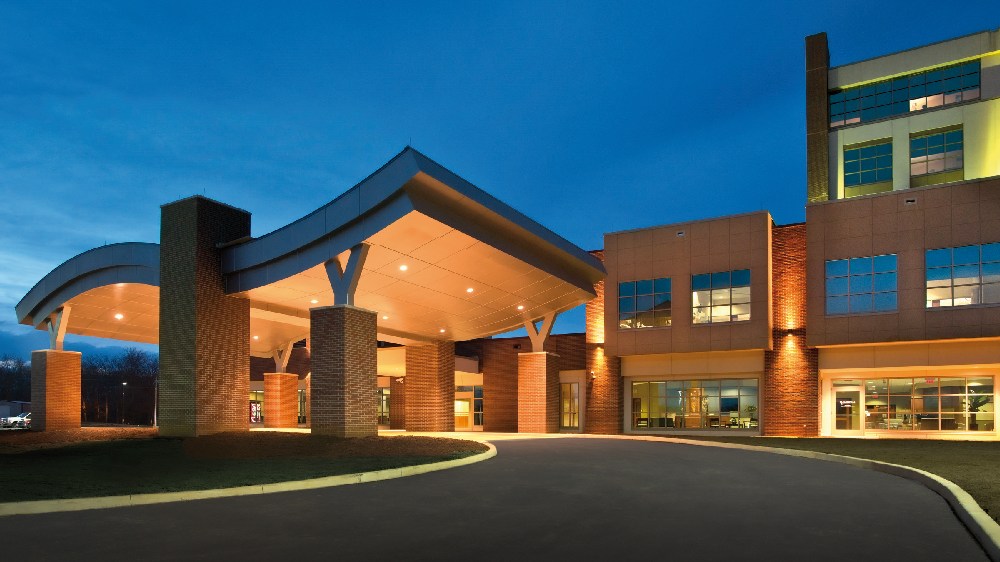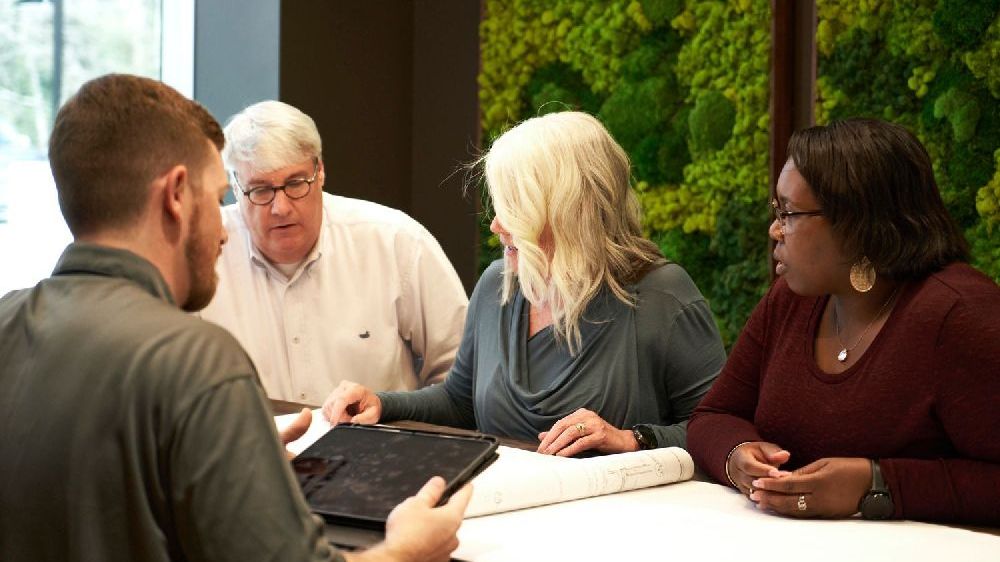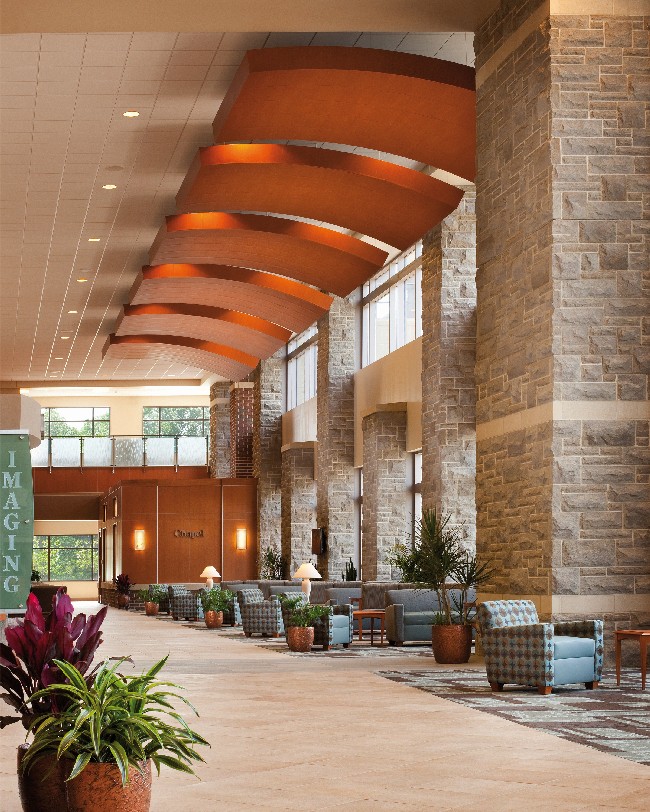 A practical yet often overlooked opportunity in any envelope strategy is reducing noise levels within patient spaces. Mitigating external sounds from passing traffic, delivery trucks, maintenance work and incoming ambulances at Magnolia Regional Health Center in Corinth, Mississippi contributes to patient healing and peace of mind. Photo credit: Michael Peck.
A practical yet often overlooked opportunity in any envelope strategy is reducing noise levels within patient spaces. Mitigating external sounds from passing traffic, delivery trucks, maintenance work and incoming ambulances at Magnolia Regional Health Center in Corinth, Mississippi contributes to patient healing and peace of mind. Photo credit: Michael Peck.  Each material choice for the Crystal Spring Tower at Carilion Roanoke Memorial Hospital was selected to complement the existing campus and its glass tower (left). The 500,000-square-foot project combines multiple brick tones, glass and metal panels to provide an energy-efficient, low-maintenance envelope system. Photo courtesy of ESa.
Each material choice for the Crystal Spring Tower at Carilion Roanoke Memorial Hospital was selected to complement the existing campus and its glass tower (left). The 500,000-square-foot project combines multiple brick tones, glass and metal panels to provide an energy-efficient, low-maintenance envelope system. Photo courtesy of ESa.  The authors see a steady shift toward the use of an integrated, early stage “brain trust” collaboration for building envelope decisions. This approach taps expertise from the entire design and construction team to creatively address supply chain and cost escalation issues. Photo courtesy of Robins & Morton.
The authors see a steady shift toward the use of an integrated, early stage “brain trust” collaboration for building envelope decisions. This approach taps expertise from the entire design and construction team to creatively address supply chain and cost escalation issues. Photo courtesy of Robins & Morton. Subscribe Now
Addressing Building Envelope Challenges with Forward-Thinking Solutions
By Barry Smith and Sam Burnette
Even before supply chain disruptions and inflation pressures changed our world, making decisions on hospital building envelopes was a complex endeavor. The global realities of 2022 reveal that decisions around planning, designing and constructing these large-scale envelope systems grow more consequential by the day.
To help clients achieve optimal outcomes and mitigate short- and long-term risks, designers and builders are harnessing the power of an integrated, early-stage “brain trust” that takes full advantage of available experiences. What we see emerging is a promising set of best practices in the planning, materials selection, design, constructability and maintenance of building envelope systems.

The scale and complexity of today’s hospital building envelopes requires purposeful planning and quality control analysis to support the design vision of the client. The lobby of the HCA Spotsylvania Regional Medical Center pulls stone and glass envelope components into the lobby. Photo credit: Kyle Dreier Photography.
Marketplace and client ROI opportunities
Anyone involved in healthcare design and construction knows there is no shortage of obstacles facing clients and their teams in the marketplace. One of the few certainties of today’s materials, labor and cost inflation marketplace is the value of early evaluation of the options for building envelope components by an integrated team.
Given the volatility in the market, this collaboration ideally includes a dynamic integration of knowledge and real-time expertise from designers, consultants, builders, trade partners, hospital facilities staff and manufacturers. This offers the opportunity to explore all options, respond to marketplace conditions and creatively apply new and evolving perspectives drawn from each discipline.
One example of how integrated teams create long-term impact is the ability to minimize the expense of labor-intensive future envelope work. We all know the shortage of skilled craft laborers will remain a long-term challenge, driving up expense and shrinking supply. For clients, finding and paying for experienced labor to replace bad sealant in a window system or within exterior joints is formidable. While there is no such thing as a maintenance-free building, it is more important now than ever to limit the expense of envelope repairs and disruptions to patients and staff.
Energy forethought generates measurable return
The more demanding energy code we must meet for healthcare, hospitals and ambulatory buildings is a minimum criterion. The future opportunity, often overshadowed by code compliance, is to exceed the minimum by making smart choices about where glass is and is not appropriate. Often, we find that clients seek a “wow” factor with an aesthetic that features a high ratio of glass curtainwall. Hospitals today may serve as signature buildings, which we applaud. But the materials and complexity of the exterior skin can make it more challenging to meet or exceed the energy codes or prevent water intrusion.
Solar heat gain issues and the reality of managing glare within interior spaces are obstacles we can address during planning and design.
Making purposeful and future-focused decisions, then designing and building lower maintenance exteriors, will create a perpetual payback for clients.
Regional understanding to gain efficiency
Another subtle but crucial factor is a team built to apply their broad understanding of the regional materials appropriate for a specific project. For example, selecting masonry in South Florida means a difficult task downstream— finding skilled masons for repair work. Besides the fact that masonry may appear out of context as an exterior product in South Florida, the goal of helping the owner achieve the best-performing, long-term payback often requires a shift from initial ideas.
The design and building team will ideally provide their evidence-based knowledge, not only about products with good long-term performance in that specific climate, but also about potential alternative choices that can be sourced and constructed in synch with the project schedule and budget.
Insider tactics for project efficiency, consistency + cost control
Labor: With such enormous attention on the cost of supply-chain constrained materials, the equal weight of labor costs needs to be part of every building envelope decision. Naturally labor-intensive products may need to be reconsidered. For example, scaffolding use, required to install the envelope in a multi-story building, needs a cost and options analysis. Prefabricated exterior panels, built offsite and installed with significantly fewer labor hours, may be a better choice.
Oversight: It’s hard to understate the complexity involved when building a modern, dependable and resilient hospital envelope. One of the complexities is continuity across all elements as construction progresses. Multiple people, including trade partners, design team members and the client, need to be aware of the issues and nuances of the envelope plan, and must make things happen as conceived and designed by the team.
A valuable tactic to head off potential disconnects during construction is for the construction manager to assign oversight and communications responsibility to a single individual. This person oversees the installations and serves as a visible liaison with the multiple stakeholders onsite. Because this individual participated in the early planning and decision making on envelope components, they can offer the oversight continuity and execute the plans and objectives across multiple groups.
Early release shell packages: One lesson gained during the past two years is the importance of getting ahead of long lead items, which include glass and roofing materials. We are also seeing long lead times in hospital construction with metal decks, elevators, structural steel, exterior door packages and anything made with zinc.
To pre-empt painful delays to the construction schedule, we are suggesting to clients that in addition to the early release of foundation and structural packages, they also approve the early release of building exterior shell packages.
Depending on market conditions, these might include the curtainwalls and building envelope materials, elevators, roof materials and major mechanical and electrical equipment that can take 12-18 months to receive.
Getting these vital items in the queue can make all the difference in meeting the schedule. This action also lets owners lock in unit pricing of these products. The tradeoff is that future options for modifying the building shell are limited once these commitments are made.
Mock-ups: To further facilitate the team approach to decision making, building physical mock-ups provide a powerful tool to test out ideas and entertain options. They allow the team to see what works best and to discover unwanted surprises before resources are unwisely spent.
The physical character of mock-ups and the ability to engage all stakeholders, including the client, in the vetting process creates a level of quality assurance upfront versus more reactive and deductive quality control later in the project. If we encounter different takes on the best solution, we keep working that out until we reach a consensus and agree on a clear course of action before any production.
Making informed, forward-thinking decisions about the building envelope requires a more comprehensive, entrepreneurial strategy in today’s medical design and construction world. By mobilizing a cross-discipline cast of trusted experts and examining the opportunities for our client, we can achieve benefits that will resonate throughout the entire life of the building.
Note from the Editor: Check out the July/August issue of MCD for additional features on healthcare building envelopes. The issue can be viewed at mcdmag.com.
Author: Barry Smith and Sam Burnette
Barry Smith is building envelope risk manager at Robins & Morton. Sam Burnette, AIA, EDAC, is a principal at ESa and serves as a principal on the firm’s healthcare design team.
Tags: building envelope, Construction, mock-ups
Posted August 17, 2022
More Articles:
- Coverings 2024
Apr 22, 2024 – Apr 25, 2024 - Hospital, Outpatient Facilities & Medical Office Buildings Summit
Apr 25, 2024 – Apr 25, 2024 - CxA Workshop & Exam
Apr 29, 2024 – Apr 30, 2024 - EMP Seminar & Exam at CxEnergy 2024
Apr 29, 2024 – Apr 30, 2024 - CxEnergy
Apr 29, 2024 – May 2, 2024 - PHCC West 2024
Apr 29, 2024 – May 2, 2024 - Lean in Design Forum 2024
May 1, 2024 – May 2, 2024










